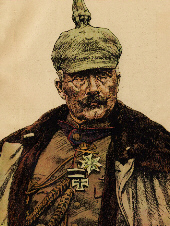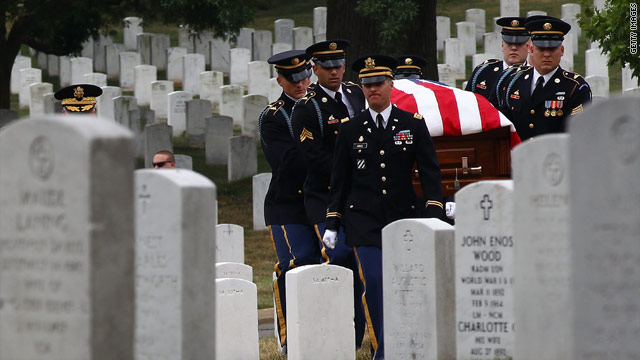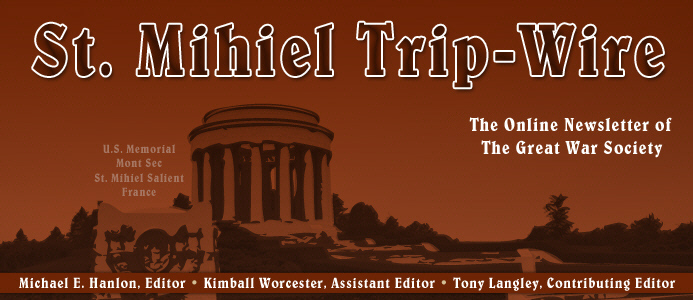

TRENCH REPORT: Presidents Steve Suddaby of the WFA-USA and Dana Lombardy of The Great War Society are both committed to seeing their organizations play a big role in the coming centennial celebration of the First World War. Like many of us, they recall that the centennial of the American Civil War in the 1960s provided a tremendous boost in interest in both the war itself and general U.S. history. In this issue's regular column, "Behind the Literary Lines," I'm giving a report about one centennial activity in which I'm playing a role. The Great War Society plans to publish an annotated bibliography on the war for distribution to anyone who "discovers" the events of 1914-1918 during the centennial celebration and wants to learn more about them. It is tentatively titled: "The 101 Best Books on the Great War," and I've been asked to organize its research (more on that below) and edit it for publication. . . MH
This Month's Internet Feature
Biographical Sketches of Interesting Individuals
Pietro Badoglio
Albert Ball, VC, DSO, MC
Louis Franchet d'Esperey
Dr. Elsie Inglis
Horatio Herbert Kitchener
Erich Ludendorff Before the Great War
New at Our Own & Our Friends' Great War Websites
Click on Title or Icon to Access
|
At Great War Society Sites
At WFA-USA Sites
|

It is not widely known that the British and French attempted to change history by making a concerted effort to kill the Kaiser from the air in Belgium, France, and Turkey. They also came close by accident on two occasions, once missing his train in Germany by only a few hours. The Kaiser, paradoxically, was more careful of his British royal cousins, expressly forbidding Zeppelin raids near royal palaces or locations where they were meeting. For instance, there were several attacks by the British and the French on various German headquarters where the Kaiser was believed to be visiting. On 1 November 1915, the British attacked the headquarters at Thielt, Belgium, dropping 32 bombs at a building where he was supposed to be. According to French historian René Martel, reports of the Kaiser at the German General HQ at Mézières brought air raids in 1915. (From Steve Suddaby)
|

Post-Lusitania U.S. Poster,
Fred Spear, 1915 (?)
|
GREAT WAR 2010 EVENT CALENDAR
|
A World War I Event Calendar
We continue to add important events to our WWI Calendar. There is simply more information than we can display here on the Trip-Wire. It is available for all, however, by downloading it from our Website.
(download calendar as Word document)
|
WFA-USA & TGWS Joint Annual Seminar
September 10-11, 2010
National World War I Museum,
Kansas City, MO
(Program and News)
|
Western Front Association
U.S. Branch Chapter Meetings
Check for Your Region
Regularly Updated (details)
|
Great War Society Monthly Chapter Meetings
Berkeley, San Francisco, and
Palo Alto, CA
Regularly Updated (details)
|
Upcoming Events at the National World War I Museum
Kansas City, MO
Regularly Updated (details)
|
Send additions/corrections for our master schedule:
Email Response
|
The Next Big Thing: We are picking up on a very interesting convergence. Commentators on the war with Islamic fundamentalists have discovered the 1915 Fatwah encouraged by none other than Kaiser Wilhelm II. Thus, another connection is being noticed between affairs of the Great War and the emerging 21st century world. For example, check out this review of The Berlin-Baghdad Express: The Ottoman Empire and Germany's Bid for World Power, 1898-1919, by Sean McMeekin, published recently by Allen Lane. (link) Watch for more stories on this topic.
To commemorate the 94th anniversary of the Battle of the Somme, the Historial de la Grande Guerra in Peronne has opened a new exhibition on gas and chemical warfare. It runs until 28 November 2010.
(link)

When I took a decision or adopted an alternative, it was after studying every relevant -- and many irrelevant -- factor. Geography, tribal structure, religion, social customs, language, appetites, standards -- all were at my finger-ends. The enemy I knew almost like my own side.
T.E. Lawrence,
Intelligence Preparation of the Battlefield
|
|
|
|
|
Page Two
|
|
|
 |
A Unique Weapons-System for
World War I Battleships |
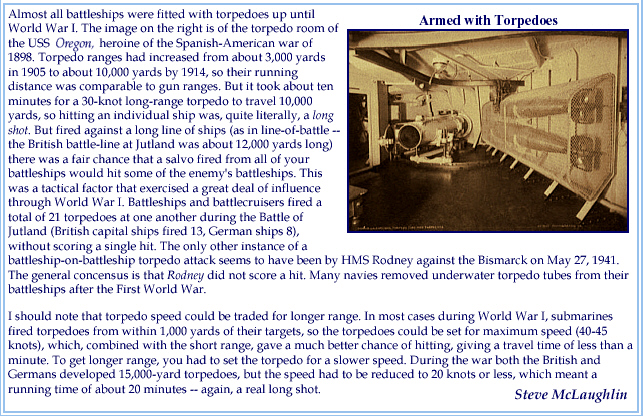
Originally presented in the May 2010 Over the Top magazine
|
|
World War I Headlines
in the
21st Century
|
|
Christina Holstein's
Sleeping Beauties
|
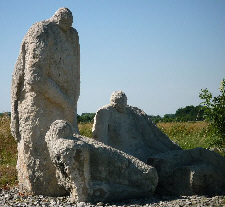
Three-Person Statue
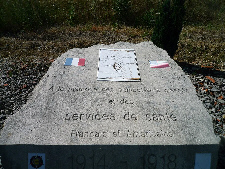 Marker
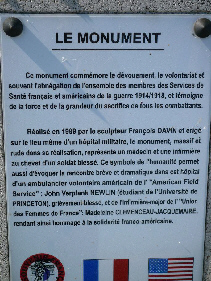 Inscription
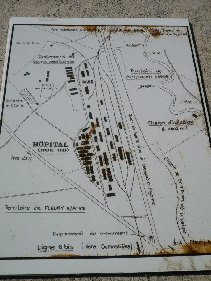
Map of the Hospital
|
To the east, west, and south of the city of Verdun are traces of the former wartime hospitals and medical units that served the French Army during the First World War and, in particular, during the ten months of the Battle of Verdun 1916. As many of these units were housed in tents and wooden huts the only traces visible today are earth embankments, remnants of old railway lines and extensive cemeteries.
Such a place is the site of the former hospital at the small village of Fleury-sur-Aire, which treated some 116,000 wounded between May 1916 and February 1919. Lying some 25 kilometers southwest of Verdun city and served by an extensive road and rail network, this hospital was one of the most important in the Verdun region. As such it attracted eminent personalities in the medical world -- experienced surgeons, medical professors, and highly qualified nurses, among them Madame Jacquemaire-Clemenceau, the daughter of the president of the French Republic.
Today the entrance to the site is marked by a group of memorials, of which the centrepiece portrays a meeting between a doctor, a nurse, and a seriously injured patient. The nurse is Mme Jacquemaire-Clemenceau and the patient is John Verplanck Newlin, age 19, an American volunteer ambulance driver from Princeton University. He was the son of Mr and Mrs R. M. Newlin of Whitford, PA.
On 3 August 1917 John Verplanck Newlin was seriously wounded in the performance of his duties and died two days later. He had been twice decorated for bravery. In 1945 an ambulance of the American Field Service was named in honour of John Verplanck Newlin. AFS records show that WD# 1324611 AFS# 174 "John V. Newlin" served with the 14th Light Field Artillery, the 168th Light Field Artillery, the 52nd New Zealand MDS, the 3rd Light Field Artillery, and also on detachment with the King's Dragoon Guards. During this period the John Newlin ambulance carried 186 patients and travelled. 6056 miles.
On 25 January 1918 the hospital at Fleury-sur-Aire was transferred to the American Army and it remained under American control until the Armistice. By portraying the French nurse and the American volunteer together, the sculptor, Francois Davin, sought to render homage to Franco-American friendship both during the First World War and at the present time. The body of John Verplanck Newlin now lies in the American military cemetery at Romagne-sous-Montfaucon, Dept. of the Meuse.
More information at:
http://net.lib.byu.edu/estu/wwi/memoir/AFShist/Mem2.htm
http://www.ourstory.info/library/4-ww2/Hobbs/texts/text4.html
|
|
|

|
Gustave Doré
|
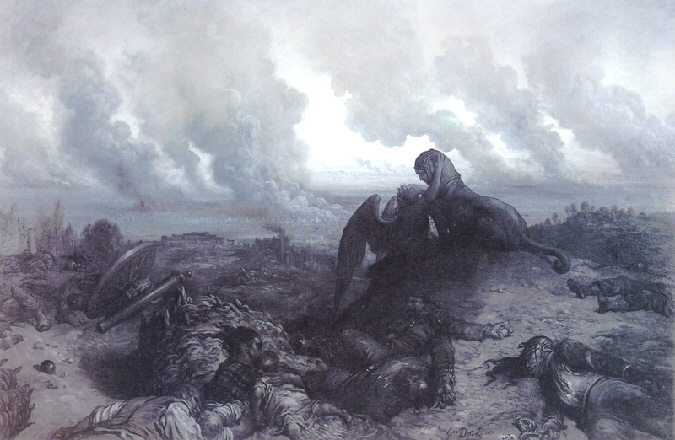
Enigma, 1871
Tony Langley is traveling this month, so I'm presenting something on his behalf that some of our San Francisco chapter members recently discovered at a visiting exhibit from the Musée d'Orsay, Birth of Impressionism at the De Young Museum. It's the sort of thing Tony finds irresistible. French illustrator Gustave Doré, stirred by the disastrous defeat in the 1870-71 war with Prussia, created a battlefield scene more from the 20th century than his own. The "enigma" seems to involve the centerpiece of the painting, a gargoyle and a sphinx embracing -- an enigma, indeed.
|
Click Here to Visit the Website of Our Contributing Editor Tony Langley
War in a Different Light

|
|
Subscribe to Our Online Magazine
|
|

|
|
|
Page Three
|
|
|
The Return of Monuments and Memorials Archivist
Sidney Clark
Over the years, we have had frequent contributions from Grenadier Guards veteran Sidney Clark, who has a great eye (and nose) for interesting monuments to those who served in the First World War. Our correspondent has been a little under the weather recently, but this month he returns with these photos of the British memorial near Basra, Iraq.
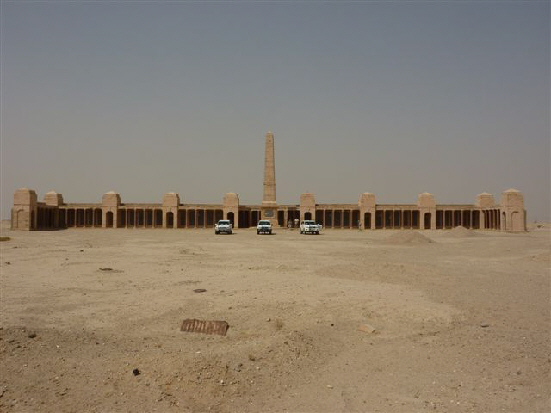
I have a friend who works in Iraq and is a member of the rifle club. He has kindly offered to take photographs of the Basra War Memorial on my behalf. The American connection is that I have the names of nine Americans who served in British regiments during the First World War whose names are engraved on this memorial. I will research these names and hope to forward anything that may be of interest.
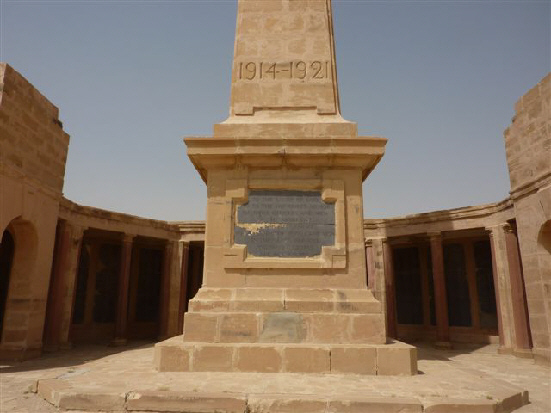
The Basra Memorial commemorates more than 40,500 members of the Commonwealth forces who died in the operations in Mesopotamia from the autumn of 1914 to the end of August 1921 and whose graves are not known. Until 1997 the Basra Memorial was located on the main quay of the naval dockyard at Maqil, on the west bank of the Shatt-al-Arab, about 8 km north of Basra. Because of the sensitivity of the site, the Memorial was moved by presidential decree (Yep, Sadam Hussein). The move, carried out by the authorities in Iraq, involved a considerable amount of manpower, transport costs and sheer engineering on their part, and the Memorial has been re-erected in its entirety. The Basra Memorial is now located 32 km along the road to Nasiriyah, in the middle of what was a major battleground during the (first) Gulf War. (Details from the CWG Website)
|
|
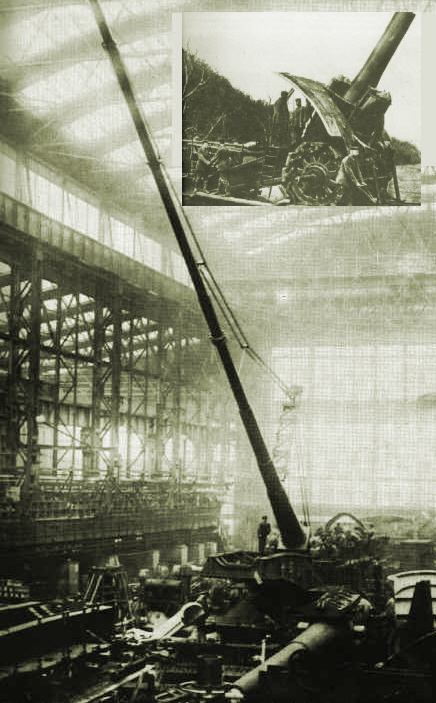
Let's Get This Straight:
The really long one is the 210mm "Paris Gun", which had a range of 80 miles and was used to shell Paris in 1918. The insert shows the 420mm siege gun, nicknamed "Big Bertha," used to great effect in reducing forts early in the Great War. Both were manufactured by the Krupp Works in Essen.
|
 |
Coming Soon!
The 101 Best Books on the Great War
An Interim Report by Project Manager Mike Hanlon
|
In anticipation of the coming centennial celebration of the First World War, TGWS president Dana Lombardy, upon taking office, asked me to organize an effort to identify the very best books about the war. The final distillation of that effort would be an annotated bibliography that could be distributed to anyone whose interest is raised by the events, news stories, and retrospectives surrounding the centennial. The working title we agreed on is The 101 Best Books on the Great War. The initial publication of the bibliography would be by subsections in the Society's quarterly journal, Relevance, during the run up to the centennial.
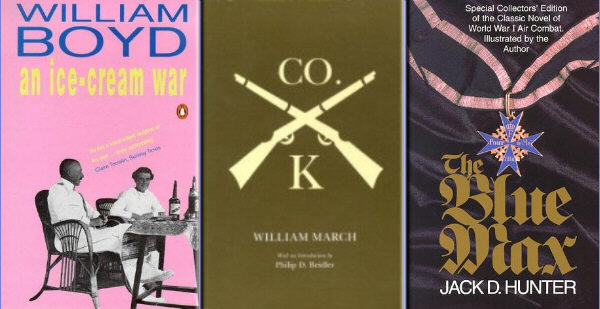
Candidates for Our "Fiction and Poetry" Listing
For over a year, we have been soliciting recommendations from our readers and members on their favorites. Thus far I've received 80 to 90 different suggestions. In the meantime, I have wrestled with how to organize the final presentation and also how to assure the ultimate consumers of the product that the list is authoritative, balanced, and based on a thorough screening of the Great War's literature. I've concluded that we need a panel of experts on the war to advise us and screen the candidates category by category. The network of World War I organizations (WFA-USA, League of WWI Aviation Historians, TGWS, etc.) is overflowing with well-read and highly respected authors who can advise us. A number of them have already expressed interest in playing a role in producing the bibliography.
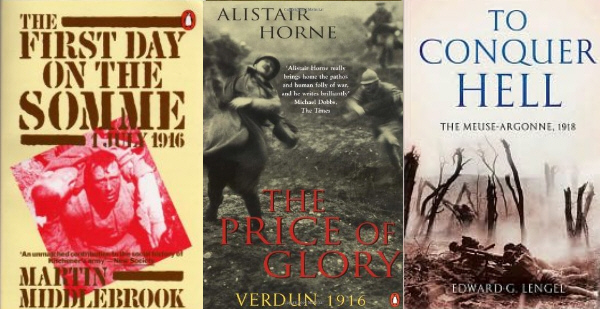
Candidates for Our "War on Land" Listing
Frankly, though, I haven't yet finalized the advisory panel, because I've been wrestling with another issue for months. Just how do you organize everything that has been written about the war? What sort of system of categories could be invented to cover all possible writings about the war that was manageable in size and allowed readers to find titles easily in their area of interest? I'm not sure that I'm there yet, but below is the system I've devised. I'm not locked in to it, and I'm interested in your comments. Also, if you haven't sent me your recommended titles, please do so. The list will be circulated to our panelists to make sure we don't overlook important works. Just email me at: greatwar@earthlink.net. Here is the tentative outline for The 101 Best Books on the Great War.
- 1. General and Comprehensive Treatments
- One and Multi-Volume Works; Maps; Pictorials
- 2. The War on Land
- Campaigns, Battles, Weapons, War Plans, Trench Warfare
- 3. The War at Sea and in the Air
- 4. America in the Great War
- 5. Personal Experiences of the War
- Memoirs, Biographies, Compilations
- 6. Fiction and Poetry
- 7. Diplomacy, Politics, and Finance
- 8. Home Fronts, Volunteers, Social Issues, Medicine
- 9. The 100-Year Heritage of the Great War
- Versailles to the War on Terror
- 10. Members' Top Recommendations
-
|
|
|
|










